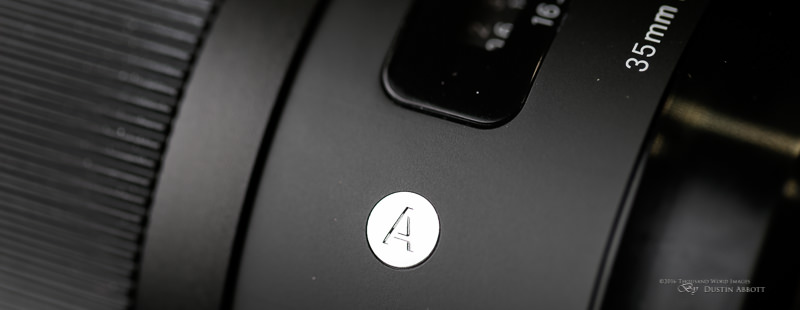
I recognize that I’m a little late to the party in reviewing the Sigma 35mm f/1.4 DG HSM ART lens. It has been on the market for more than three years, and has gotten both writer’s ink and photographer’s dollars like no Sigma lens before it. I had never reviewed the lens previously, but when the Canon EF 35mm f/1.4L II USM was released I knew a lot of people would be interested in knowing how it compared to the current benchmark in the industry, and shockingly, that benchmark was not made by Canon, Nikon, or Zeiss; it was made by Sigma. Just pause for a moment and consider just how incomprehensible that would have been four or five years ago. Four years ago most professionals sneered at the notion of owning a Sigma over a first party lens, despite the release of a fairly good EX 50mm f/1.4 and a very good EX 85mm f/1.4. But Sigma (along with Tamron) was still stuck in a third party/third world mentality, namely, that their niche was to offer budget alternatives to first party lenses that undercut them in price, offered competitive optical performance, but were usually inferior in build and autofocus performance. Then Sigma shocked the photography world at the end of 2012 by introducing this beautiful new lens that looked nothing like a Sigma. The Sigma 35mm f/1.4 DG HSM ART lens launched Sigma’s rebranding/coming out party with their Global Vision initiative.
Part of this was a completely new branding system for their various products. Sigma abandoned the EX designation and instead introduced a three-pronged approach of “Art”, “Contemporary”, and “Sport” lines. A few of these categories are admittedly vague (what exactly makes a lens “Contemporary”?), but there is no arguing with the direction the design team has taken with the lenses designated “Art”. Sigma not only dramatically improved upon their older design (which frankly I was not a huge fan of), but have designed some of the best looking modern lenses, period. I’ve reviewed the 50mm, 18-35mm, 24-35mm, and now this lens from the ART designation, along with the 150-600mm in both “Sport” and “Contemporary” variants, so the new Sigma look is not quite so new any longer, but I still favor it over most all other lens designs.
I decided to go ahead and do a review of the Sigma 35mm f/1.4 ART (35A for short henceforth) that took into account the new releases from Canon and Tamron. Sigma is no longer the de facto choice, but do these new options make it any less deserving of your consideration?
Build Quality and Design
There is a very pleasing blend of glossy, matte, and ribbed surfaces that has both a modern yet elegant design. The “flocked” finish is a thing of the past (good riddance, I say), as is the gold ring that seems almost garish now when presented with this sleek, understated new design. Yes, the lens is essentially all black with some small white print in a few points, but the blend of textures keeps the lens from being monochromatic or boring. The lens has small white text on one side that says, “Made in Japan”, an understated SIGMA brand on the top, and then the lens designation and filter thread size near the distance window of the top of the barrel. Less obvious is a very small sized serial number in a grey text that is only obvious under close examination. An elegant little silver circle with the letter A (for ART) rests next the focus distance window. On the bottom of the barrel is an 0xx number which clearly and obviously states the year of manufacture (bravo for simplicity!)
The lens has four distinct bevels that flow into a wider section as you move towards the front element. The first bevel flares from the lens mount section into the area of the distance window and the single switch that controls focus (Auto/Manual). The HSM (Hypersonic Motor) allows for full time manual override. The next bevel moves into the slightly wider focus ring. It has a nicely ribbed, slightly rubberized texture. The movement isn’t as smooth as, say, Tamron’s new 35mm f/1.8 VC lens. I find the damping a little on the heavy/stiff side, but on the plus side it doesn’t feel “gritty” at all. Manually focusing the lens is also limited by a very short “throw” distance, particularly between about 6 feet and infinity. Making a fine manual adjustment is difficult in that range due to the very small focus throw of only about 90 degrees (the Tamron 35 VC has nearly double that!). The final flare is to the front of the lens where the lens hood bayonet attaches with a soft touch material transition to the hood that still impresses me when I encounter it even after seeing it on 5 or so other lenses. This is a very classy approach to lens design that borrows a page from Zeiss more than any other design.
If there is a shortcoming here it is that the lens does not have any kind of weather sealing. In that sense the beauty is only “skin deep”. At the time that this lens was released, that wasn’t really a big deal, as the main competitors from Canon (35L) and Nikon (35mm f/1.4G) also lacked any kind of weather sealing. But that has changed with recent releases, and while the Canon 35L II is twice the price of the Sigma (and is thoroughly weather sealed), the Tamron 35mm f/1.8 VC is not only nicely weather sealed but also undercuts the Sigma’s price by $300 (at least in the US market).
While it is not surprising that this lens lacks weather sealing, I am surprised that all new subsequent ART series releases (including the very new 20mm f/1.4 ART) continue to lack it. Sigma seems to be reserving this for their telephoto lenses at the moment. Tamron has seized this as means of differentiating its new SP series of primes, and if that line enjoys success one wonders if Sigma will persist in not adding weather sealing to the design of future ART series lenses.
This lens got a lot of publicity due to having (at the time) class leading resolution and a beautiful lens design. A great price didn’t hurt. It was introduced at $899 while the Canon 35L was closer to $1500 and Nikon 35G even more. It’s release managed to completely overshadow the release of Canon’s excellent EF 35mm f/2 IS, a lens that was quickly relegated to being one of Canon’s “underrated gems”. I actually chose that lens over the Sigma back then, and it has served me well for years, but it seems like only now is it starting to receive recognition for being a stellar lens. The larger aperture, beautiful design, and amazing resolution of the Sigma caught the attention of the public. Suddenly it was entirely acceptable for professionals and amateurs alike to own a Sigma, and the success of the 35A (Sigma 35mm f/1.4 ART) helped launch a whole series of lenses in the ART line since.
But it is now 2016, and Sigma faces pressure from an excellent lens beneath it in price (the Tamron), and a new class leader above it (the 35L II). The debate about the merits of the original 35L vs. the Sigma 35A went back and forth, but there were a number of points that could not disputed: the Sigma was much, much sharper at wide apertures and had far less chromatic aberrations. The 35L might have a better drawing (global look to the images), but that is something that doesn’t show up on a test chart, and in every “chartable” category the Sigma was coming out on top.
But Canon has finally struck back, and the Canon EF 35mm f/1.4L II USM manages to raise the bar once again in almost every category…but it is also twice as much money. Here’s a look at the raw numbers:
| Lens | Sigma 35mm f/1.4 ART | Canon 35mm f/1.4L II | Canon 35mm f/2 IS | Tamron 35mm f/1.8 VC |
| Price (at time of review) | $899 | $1799 | $549 | $599 |
| Overall Length | 94mm | 105.5mm | 62.6mm | 81.3mm |
| Overall Weight | 665g | 760g | 335g | 479g |
| Front Filter Thread | 67mm | 72mm | 67mm | 67mm |
| Elements/Groups | 13/11 | 14/11 | 10/8 | 10/9 |
| Min Focus/Max Mag | 30cm/.20x | 28cm/.21x | 24cm/.24x | 20cm/.40x |
| Aperture Blades | 9 | 9 | 8 | 9 |
There is one figure here where Sigma lags behind several competitors that I will note, and that is in minimum focus distance/maximum magnification. This has been and continues to be an area of strength for the 35mm focal length. 85mm lenses typically have very poor figures here (a maximum magnification figure of .11-.13x is common), and even 50mm lenses (where the standard used to be around .15x), but 35mm lenses have always bettered those figures. The Sigma’s ability to focus down to one foot/30cm and have a .20x magnification (1/5th life size) is useful, but not nearly as useful as the Canon 35 IS at .24x and is doubled by the Tamron’s .40x figure (one of the greatest strengths of that lens!).
The Sigma was a large lens upon its release, but there has been a trend towards larger and heavier lenses since its release, so the new Canon 35L II adds nearly 100g of weight and 10.5mm of length. This comparison shows that it certainly exceeds the dimensions of the Sigma in every regard.
Beyond that, however, the Sigma ART line has also seen a number of larger releases (most notably the 50mm f/1.4 and the 24-35 f/2), so the 35A is now only middle of the pack in size. It is a dense feeling lens, and is largish, but probably not so much that it will prove an impediment. Still, if low weight and small size are a priority to you, I would recommend looking at the Canon 35mm f/2 IS (Canon shooters) or the Tamron 35mm f/1.8 VC (Canon, Nikon, or Sony shooters) as those lenses offer competitive image quality and image stabilization, though at the cost of a somewhat smaller aperture (but one that is still plenty wide for most applications).
I always commend Sigma for the inclusion of a nice, padded case that offers real protection for the lens. It is much more useful than the drawstring pouch that Canon throws in with their L series lenses. I wish others would take a cue from Sigma in this nice extra touch.
Autofocus
My first act when receiving any new autofocus lens is to spend some extended time calibrating the lens to the body/bodies I intend to use it on. For this purpose I use the FoCal 2 program from Reikan. My typical process is to run the automatic calibration at least three times (I’m looking for a repeatable result) and I then follow up with a semi-automatic calibration where I take a closer look at the figure or figures that the automatic calibration produced. I will check results to either side of these figures to see if there is a better one. This allows me to both eyeball the actual focus results and ensure that I have the most consistent focus setting.
I calibrated both the Sigma and the Canon 35L II on the same day, and eventually settled on a -2 for the Sigma and a +2 for the Canon. I had a little more variability in hunting down the Sigma value, but was confident with the figure I produced. Throughout the period of my review I used the lenses in a variety of settings, from general purpose shooting to events (church, school, and family) along with some portraits. While impossible to encompass every type of shooting situation in a 4-5 week period, I feel that I used the lenses in enough of a variety of settings to be confident in my findings.
One of those events was at my children’s school. It was a “Duct Tape Fashion Show”. The 7th and 8th grade classes had fashioned various costumes and clothing items out of duct tape and paraded them up and down the “runway” in the gym. I used both lenses back and forth on the same camera body (the body they were calibrated to). I primarily shot in AF Servo mode, as the kids were always moving and rarely stopped long even when they were posing. As the official photographer for the event I was set up right at the end of the “runway” and kids came in from the far end of the gym, up the center aisle to me, then split to either side, quickly posed, and then retreated back the way they came. I shot 57 frames on the Sigma and 113 on the new Canon – all wide open at f/1.4. I used the lenses identically when shooting with the intent that I would compare frames at the end of the shoot and determine which lens had the higher hit rate.
I went through and counted 9 improperly focused shots from the Canon (out of 113), for a hit rate of around 92%. Most of these misses were with the subjects right on top of me and weren’t in situations where I would have expected to get good results. There were about 2-3 obvious misses where I would have expected accurate focus to be possible. This raises the keeper rate to better than 98% – very good under the circumstances I was shooting in.
The Sigma was another story altogether. I counted at least 15 missed focus shots, including almost all of those beyond 20 feet (all of which back focused beyond the main subjects). Here’s a case in point:
Reviewing the data in Lightroom via a plugin called “Show Focus Points” tells me that I was using AF Servo focus and that focus was locked with the center point square in the middle boy’s face…and yet the lens is actually focused on the far wall. By contrast the Canon 35L II shots in the same situation were all accurately focused.
My hit rate was highest when the subjects were in the range of 5-10 feet (the lens was calibrated at the recommended six-foot distance). The keeper rate with the Sigma dropped to under 64%. If you intend to shoot events, sports, or photojournalism, the Canon proved the much more reliable option in this scenario…and that might be worth the premium price in and of itself. If you need to shoot this style and can’t afford the 35L II, I might recommend considering the 35mm f/2 IS instead. It has a slower aperture, yes, but it has an image stabilizer and similar full ring USM focus that is extremely fast and accurate. I’ve used it for a couple of years and it has proven one of my most accurately focusing lenses.
Purchasing Sigma’s USB dock is one means of helping with this, as it allows you to calibrate focus at various distances, while the camera’s AFMA function only allows you to calibrate at one focus distance (the distance I calibrated at is the recommended distance). The dock also allows you to upload firmware updates to the lens that should, theoretically, help to eliminate future incompatibility issues should the camera manufacturer make some change to the autofocus process. This is one distinct advantage for Sigma lenses, though reports from a variety of subscribers indicate that it doesn’t always solve the autofocus issues. This has been, in my experience, the Achilles’ heel of Sigma’s ART series. Some photographers are very satisfied with the autofocus performance; others have given up on the lens in frustration. I find myself typically somewhere in the middle. I’ve had mixed results with a broad section of Sigma lenses, with only one bad experience (the copy I had of the 18-35 f/1.8 ART was quite inconsistent) but mostly fairly good results overall with occasional, inexplicable misses. Take, for example, this shot of a lingering oak leaf in the winter. The shot was stopped down to f/3.5, which gives the AF system more depth of field to work with, so I would not have expected this shot to have missed. I’ve included a screenshot from the software plugin for Lightroom called “Show Focus Points” that I use, and it shows from the EXIF data that the lens/camera indicated focus lock (middle focus point) and yet the photo (look at the crop) is clearly not really in focus at all.
In many (even most) cases I got well focused results, but the misses were more frequent than what I’m accustomed to. At wide apertures I would sometimes find that the focus was acceptable but not really nailed, either, if I examined the image at a pixel level. I’ve been spoiled by the focus accuracy of the Canon 35 f/2 IS, and both the Tamron 35mm f/1.8 VC and the Canon EF 35mm f/1.4L II performed very well for me while reviewing them. This video breaks down autofocus among the chief competitors in detail, and will give you a good idea of how the lens performed overall.
Thus far I have not found any third party lens that focuses quite as fast as the best Canon USM lenses. Large aperture primes have to move a lot of glass, and I find that Canon not only does the best job of producing speed but also the best job of masking how much effort is involved in quickly moving those elements. Sometimes with Tamron and Sigma lenses I find that major focus shifts involve a sound and sense of “sliding” as the elements move into place. That sensation is much more muted with the Canon 35L II. The Sigma is fast, for the most part, but there is a little pause while inertia builds when going from minimum distance focus back out to infinity accompanied by a slight “shhhhtck” sound as the elements slide into place.
It’s interesting to me the very different approach that Sigma and Tamron have taken with dealing the challenge of focus with large aperture primes. The Sigma 35mm f/1.4 ART has a large aperture and quite fast focus but at the expense of having a very small focus throw. It barely has 90 degrees of focus throw, and the distance between 6 feet and infinity is TINY on the focus ring. It makes manual focus very difficult and even makes me wonder if this doesn’t contribute to the lens’ somewhat poor focus accuracy in that range.
The Tamron SP 35mm f/1.8 VC takes a different route. First, it has a somewhat smaller aperture (and thus a little less glass to move), but it adds a much bigger focus range with a good 180 degrees of focus throw (basically double that of the Sigma). The Tamron takes a perception hit in its overall focus speed (which is just a tiny bit slower), but the trade off is that you can both manually focus and autofocus with a bit more precision. This is even more pronounced in the 45mm VC vs. the Sigma 50mm f/1.4 ART. Which approach is better? The answer will probably change from photographer to photographer.
If you lean towards shooting more video than stills, the Tamron is a good choice as it has the best manual focus ring (by a good measure), longer focus throw, and adds an effective image stabilizer to the mix.
Some people find that the Sigma 35A works just fine for them; others have given up despite its impressive optical performance. I have now spent time with the 35A, 50A, 18-35A, and 24-35A lenses, and my own experience has been a mixed bag. The 24-35A performed the best for me overall, and the 50A did well in spurts, but my own conclusion is that autofocus accuracy continues to be Sigma’s Achilles heel. I strongly want them to solve this issue as they really are designing lenses with very impressive optics.
In conclusion, if you are a professional and need the best, most accurately focusing 35mm lens, the Canon 35L II is the new top choice; the Sigma isn’t even close.
Image Quality
This has been and continues to be the area where the Sigma punches far above its price point. It is the reason why this lens is now in so many photographer’s kit; it delivers in the resolution/image quality department. In the past it was common for wide aperture primes to be a bit “dreamy” wide open. This was frequently caused by both a lack of contrast at wide apertures along with chromatic aberrations that would rob the lens of apparent sharpness and make images look somewhat hazy in the details. This isn’t the case with the Sigma 35A; it delivers at all apertures. Not only that, but while some primes are sharp in the center but get increasingly soft as you head out across the frame, the Sigma does a stellar job of extending that sharpness across most all of the frame.
While I recognize that lenses like this are going to be used at a variety of apertures by end users, I tend to test lenses like this primarily at apertures wider than f/2.8. The reason being that it is in this zone where prime lenses really need to show their worth. The reality is that a number of modern zoom lenses are already excellent at their wide open f/2.8 aperture, so a modern prime really needs to shine at even wider apertures to justify its existence. The Sigma 35A certainly does.
Even at f/1.4 images look crisp and sharp, providing a great “pop” of subjects from backgrounds. Even landscape type images look quite good at f/1.4. Resolution is crisp, contrast is strong, and image quality is generally excellent. Check out this landscape shot at f/1.4 and the crops from across the frame:
This was unprecedented resolution from a 35mm f/1.4 lens, and it is only now that this performance has been surpassed. The new Canon 35L II gets the edge in overall resolution, and I also didn’t feel that the Sigma produced the same degree of microcontrast as the Canon. What I mean by this is that when zoomed into a pixel level there is a higher amount of contrast and less chromatic aberrations in the details of the Canon’s images which results in the appearance of higher resolution. At f/1.4 the Canon is definitely resolving higher, and, as a result, the lens is just that much more special. I also feel like the Canon is transitioning to defocus more nicely. It’s rendering is more “magical”. It is also, of course, twice as expensive.
With either lens I was reminded of how much I enjoy the 35mm focal length as a walkabout lens. It seems to be “just right” for a number of things, and whether in the woods or on the city street the 35mm focal length seems wide enough for most everything without adding distortion. It is the “Goldilocks” focal length: not too close; not too far. For that matter, I also prefer the versatility of a wide aperture to that of a moderate zoom range. The ability to shoot most anything at f/1.4 (if you want that narrow a depth of field) gives you a lot of flexibility as to how you choose to frame a scene. In some instances, a shot of a scene with a narrow depth of field is interesting where it might just be busy with more depth of field. It’s nine bladed aperture also makes for nice sunstars/sunbursts when stopped down.
I used the lens as a part of documenting our Christmas celebration this year, and after sharing the images one of my sisters-in-law remarked that I always make everything look so “sparkly”. A big part of what she is referring to is that special 3D quality that high quality optics give to photographs. Wide aperture primes have the ability to make everything (even ordinary things) look just a little bit more special!
Sigma did a good job of suppressing chromatic aberrations with the optical elements and coatings. While not nonexistent, the chromatic aberrations are well controlled and rarely objectionable in any way. You will see a little bit of green fringing in the out of focus area occasionally like this:
Canon has once again leapfrogged Sigma in this area, but I would say that the Canon advantage might be seen more in the microcontrast than in green or purple fringing in typical images. In this video segment I really break down resolution and overall image quality in detail:
Another strength of this lens is a near complete lack of distortion. I really noticed how nicely this helped when shooting handheld exposures to be combined in a panorama – everything lined up nicely. It makes it a very reasonable lens to shoot architecture with, though 35mm isn’t as wide as one might like.
The type of images that the Sigma is capable of is truly impressive. That incredibly sharp resolution on the subject at wide apertures was and is revelatory. You can view many more samples in the Sigma 35mm f/1.4 ART Image Gallery.
Optical Weaknesses?
The only real fly in the ointment optically is the very heavy vignette. It isn’t exceptionally bad (the 35L II is basically the same, although the new Tamron 35mm f/1.8 VC is far and away the winner in this area), but will be noticeable in a wide variety of settings. This is pretty common for wide aperture primes used at wide apertures. In some cases a vignette produces a desirable effect, but I would rather add it in post rather than have to remove it. Add to this that you won’t be able to load a profile to correct for this in JPEGs to your camera, though correction to RAW images is simple in post processing.
I was also less than amazed at the flare resistance. I had a chance to shoot in highly directional sun while visiting the Mer Bleue conservation area in Ottawa, Ontario, Canada. This is one of the most studied bogs in the world, and provided some very unique shooting opportunities. The setting sun was both intense and very directional; a perfect storm for testing flare resistance. Neither the Sigma 35mm f/1.4 ART nor the Canon 35LII really impressed me; I’ve seen much better performance from both the Canon 35mm f/2 IS along with the Tamron SP 35mm f/1.8 VC. Neither lens has as wide an aperture, true, but both are genuine competitors that performed better in this regard. The 35L II retained somewhat better contrast (the Sigma veiled a bit more), but both showed a bit more ghosting artifacts than what I would like – and those can be very difficult to remove in post. I don’t mind a bit of veiling (it often creates a stylish effect), but ghosting artifacts can ruin an image. Here’s a quick video segment showing flare resistance from the Sigma and its chief competitors.
Still, as you can see, the list of optical objections is pretty short when compared with the numerable strengths of the lens.
Bokeh Quality
Determining a lens’ bokeh quality is somewhat challenging because bokeh is both a subjective measure (the Helios 44-2 “swirly” bokeh is either wonderful or terrible depending on your perspective) and it is also notoriously difficult to demonstrate in a controlled test. Since its introduction there has been some debate about the bokeh quality from the Sigma. I myself have referred to it as being somewhat “clinical”, and feel that the lens tipped the scales more towards sharpness than overall drawing. The reality is that while the lens is perhaps not exceptional in this regard, it is in no way objectionable either. I’ve been using the lens side by side with the Canon 35L II over the past five weeks, and while I instinctively prefer the “look” of the images from the 35L II, the reality is that the differences are subtle at most.
Bokeh is a matter of taste, but one area where I can measure it is in how a lens handles bright out of focus specular highlights. I did a controlled test to compare the quality of the bokeh highlights. The subject (an old 35mm f/3.5 Super Takumar lens) was 17” from the sensor. The bokeh highlights (Christmas tree lights) were about seven feet beyond. I lit the foreground with a Metz 64 AF-1 flash through a Lite Genius Super-Scoop II and bounced off a wall behind the camera. I used mirror lockup, 2 second timer delay, Live View 10x focus, and Rear Curtain sync to produce the smoothest light falloff result. I determined that I best liked the look of the image with a ¾ stop underexposure by the camera’s meter. For what it is worth, the Sigma needed a bit more light according to this metering method, so there is a minor variance in exposure values. I expect that DXOmark or others who measure the lenses T-stop performance will find a shade better performance for the 35L II. The 35 f/2 IS, which I also used in this comparison, had a t-stop value equal to its f-stop (f/2), while the Sigma 35A clocked in at a t-stop of f/1.6, which is actually fairly decent compared to earlier generation competition.
When comparing the Sigma 35A and Canon 35L II side by side at a wide open f/1.4 aperture it is actually surprising how similar the bokeh highlights looked. The shape of the highlights is roughly the same, and while there is just a hint of additional busyness in the Sigma’s highlights, that is only detectable at 1:1 pixel level. The Canon shows a slight bit more concentric rings while the Sigma shows more of a pattern. As you move away from the center of the frame both lenses show a tendency towards lemon shapes instead of circles – a pretty common phenomenon. At identical exposure the Canon’s image is noticeable brighter, but probably no more than a quarter stop.
Stopping down to f/2 helps correct the lemon or cat-eye shape, but also further accentuates the signature of both lenses. The Sigma is bit more “patterned”, and the concentric circles are slightly more defined on the Canon. The Sigma does a slightly better job of retaining circular shape, with the Canon showing the first hints of the shape of the aperture blades.
Little changes at f/2.8, although now both lenses show the slight shape of their aperture blades at a 1:1 level to a similar degree.
By f/4 both lenses are producing highlights looking more “nonagonal”. The shape of the aperture blades is now clear, though the result is far less objectionable than the odd shape of the old 50mm f/1.8 and its five blades. There is also far more light bleed around the edges of the shapes, but roughly at an equal level from both lenses. Ditto at f/5.6, just a step further. Here is a series from the Canon from f/1.4 to f/5.6:
Here is the same series from the Sigma:
The Canon 35 f/2 IS has perhaps the smoothest bokeh of any of the 35mm options, but I don’t see a major advantage in this kind of testing – and that bodes well for both these lenses. The bokeh highlights from 35IS look remarkably similar to those of the 35L II.
Here is the Canon 35 IS series:
While I don’t have the new Tamron SP 35mm f/1.8 VC on hand for this comparison, I did a similar test a few months ago and did add the Tamron SP 45mm f/1.8 VC which I had on hand to the test as another point of comparison. You can see something similar in my review of the Tamron 35mm f/1.8 VC. The longer focal length of the Tamron 45 VC here means that the size of the bokeh highlights are larger, but the bokeh highlights are also noticeably busier than any of these other contenders. Most Tamron lenses I have tested have shown a tendency towards the phenomenon often called “onion bokeh”, though the 45VC also shows the reason why its bokeh looks so nice in most other situations – the inner line of the bokeh circle is nice and soft and thus produces bokeh without hard edges.
Both the Sigma and the Canon 35L II will produce less busy highlights than the Tamron 35 VC when bright light sources are in the scene. Where the Tamron will win over all of these is in the amount of bokeh it can create in some situations due to being to focus much closer and having a maximum magnification figure twice that of Sigma (.40x).
But as I said before, this test really only shows bokeh quality in one very specific way, and doesn’t tell the whole story. I would encourage you to judge the quality of the bokeh from any of these lenses based more on real life usage rather than any isolated test. Bokeh quality is always a subjective thing, and most all of these lenses produce very good real world results…including the Sigma. Here is a little gallery with a few bokeh examples:
In Conclusion:
The merits of this lens are not going to be determined by my conclusions. Over the past three years this lens has received both critical and commercial success, and is, in my opinion, perhaps the most important lens that Sigma has ever made. Sigma was able to completely redefine its position in the market based primarily on the strength of this lens. It is telling that while chart tests show an advantage in resolution for the new Canon 35L II, that advantage is slight despite three additional years of development and a price point double that of the Sigma. The new Canon’s advantage in image quality is a matter of degrees, but it certainly has a stronger advantage in autofocus consistency. That remains the one area that might should give you pause when considering the Sigma 35mm f/1.4 DG HSM ART. There is little else to strongly criticize, and some have reported having good autofocus success with their own copy. As the saying goes, “Your Mileage May Vary”. If your budget doesn’t extend to the new Canon 35L II, and you feel you need an f/1.4 aperture, then the Sigma remains the clear choice for quality optics at a reasonable price. I guess some things haven’t changed.
Pros:
- Set a new standard for optical performance at the 35mm focal that has only now been mildly surpassed
- Beautiful and functional build
- Well controlled chromatic aberrations
- Low distortion
- High resolution even wide open
- Fast and quiet autofocus
- Includes nice padded case
- Excellent value to performance ratio
Cons:
- Autofocus performance can be inconsistent
- Fairly heavy vignette
- Flare resistance could be better
- Lacks weather sealing
Alternatives:
The new Canon 35mm f/1.4L II USM is now the class leader for Canon shooters and surpasses the Sigma is most metrics. I reviewed it here. It rings in at twice the price of the Sigma.
I reviewed the new Tamron SP 35mm f/1.8 VC a few months and was very impressed by it. It has a somewhat smaller aperture value (f/1.8) but offers up a professional grade, weather sealed build quality, great optics, and adds an image stabilizer to the mix. It also retails for three hundred dollars less.
The Sigma 24-35mm f/2 ART is also an interesting alternative. It has a slower aperture but delivers similar image quality along with a small zoom range. I reviewed it here. It retails for a hundred dollars more.
The Canon 35mm f/2 IS has a slower aperture but has great focus, a wonderfully compact size, and a very effective image stabilizer. It is a bargain at $549. I reviewed it here.
Review notes: I reviewed retail copies of both the Canon 35L II and Sigma 35A provided to me by the great people at B&H Photo .
Gear Used:
Canon EOS 6D DSLR Camera (Body Only)
Sigma 35mm f/1.4 DG HSM ART Lens
Adobe Lightroom CC Software for Mac and Windows (Boxed Version)
Adobe Photoshop Creative Cloud 1-Year Subscription
Alien Skin Exposure X (Use Code “dustinabbott” to get 10% anything and everything)
Purchasing your gear through B&H and these links helps fund this website and keeps the articles coming. Thank you for your support.
Great News! I can now offer a 5% discount on all purchases at Amplis Foto, Canada’s Leading Photographic Supplier. Please enter discount code: AMPLIS52014 in your cart. It is good for everything in your cart, and is stackable with other coupons, too! It will take 5% off your entire order! Proceeds go towards keeping this site going and providing you with new reviews!

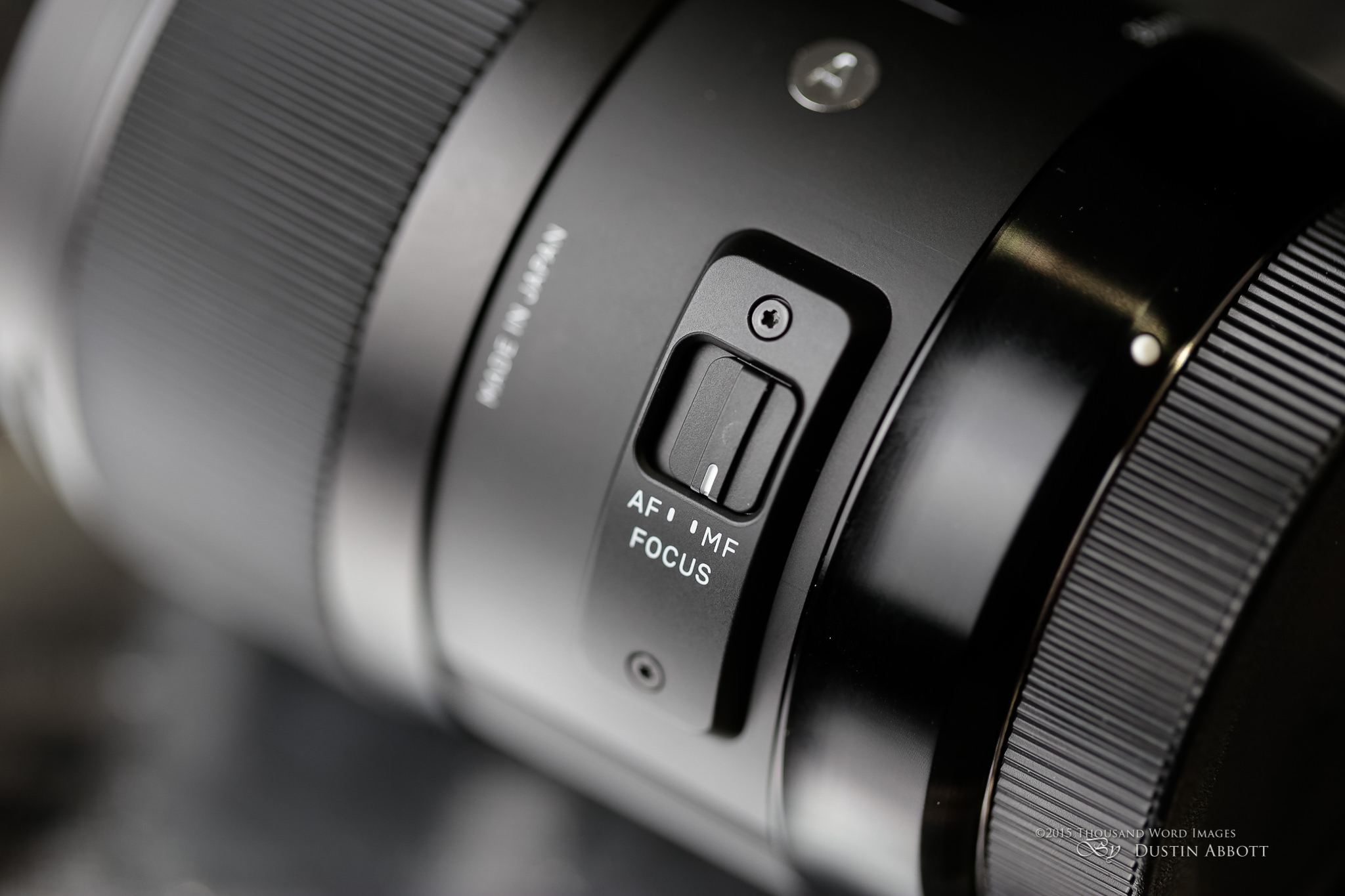


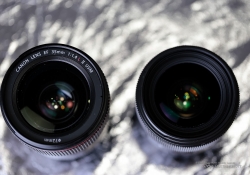
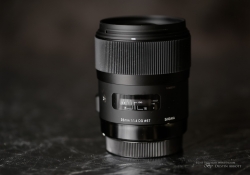
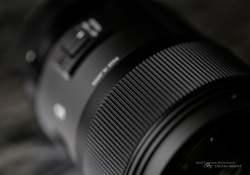
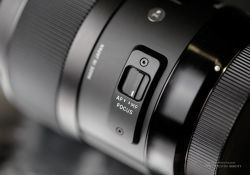
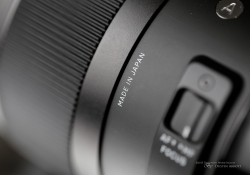
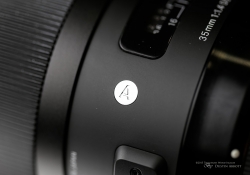
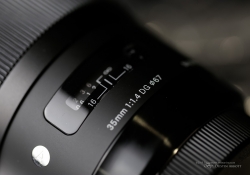
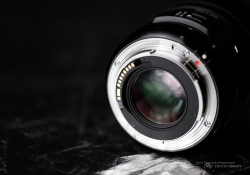
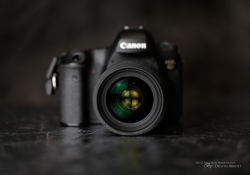
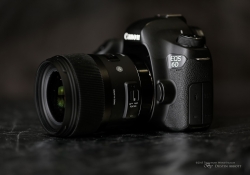
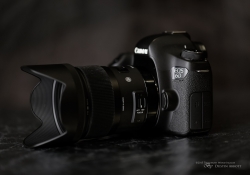
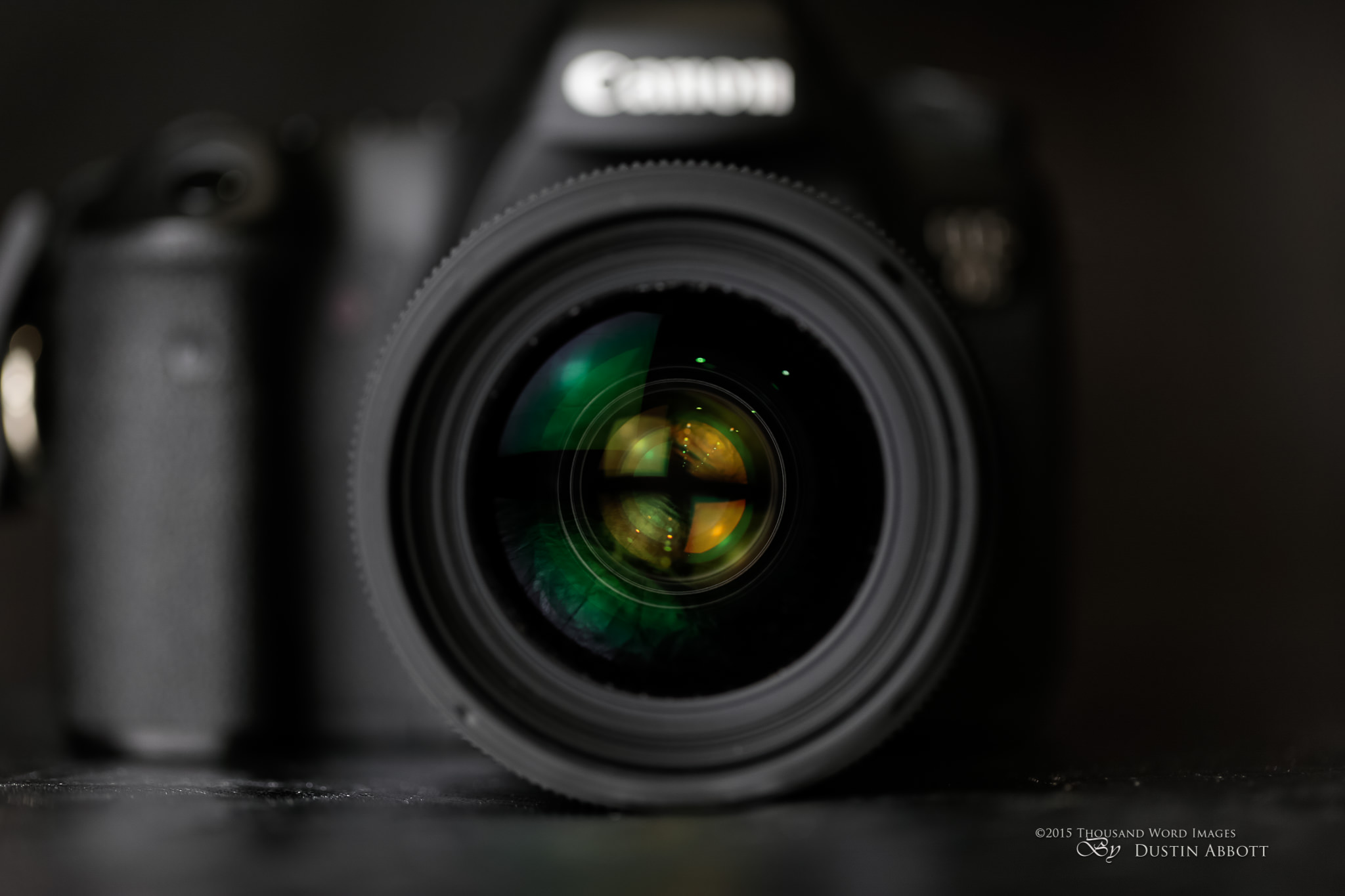
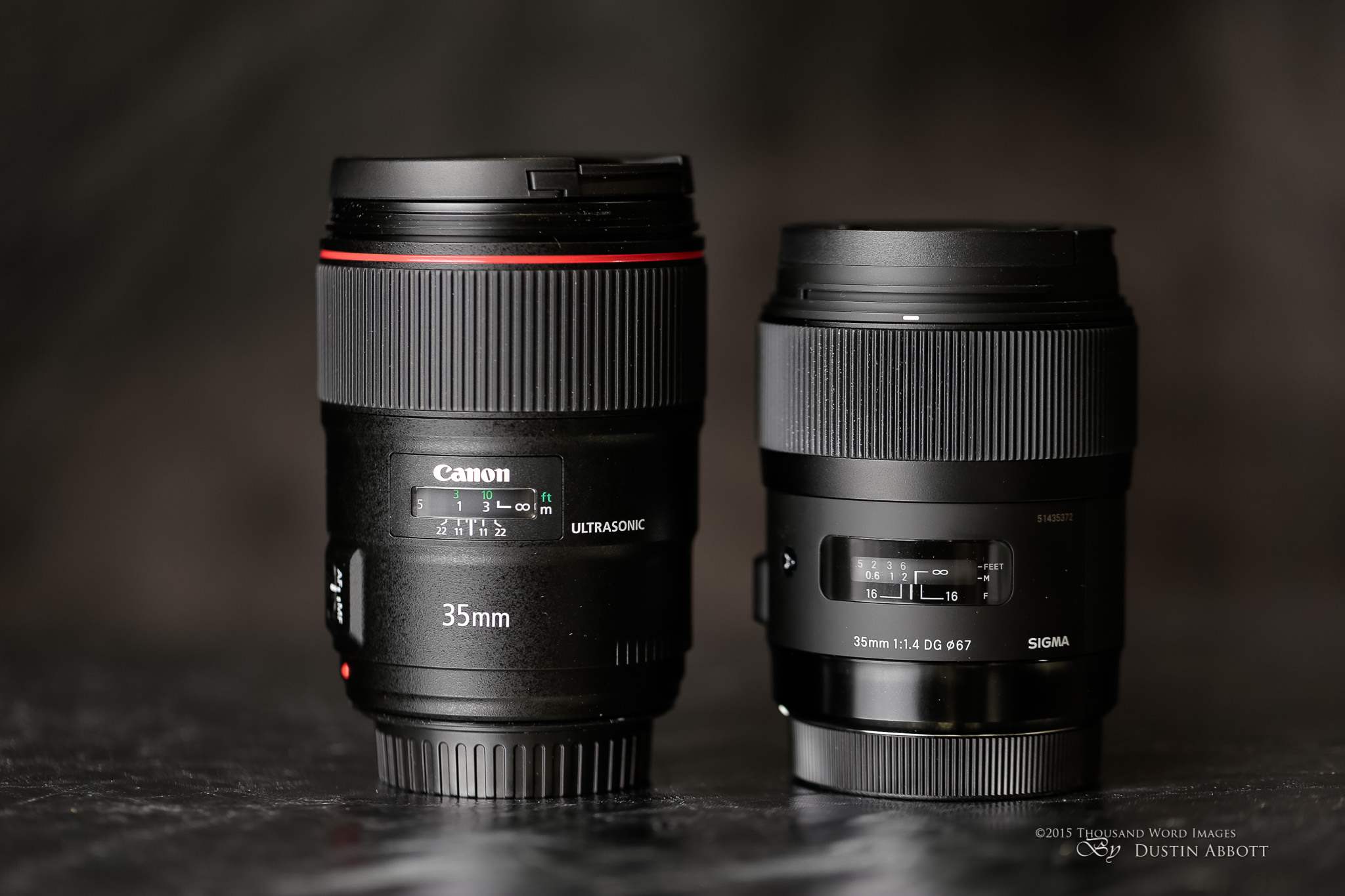

















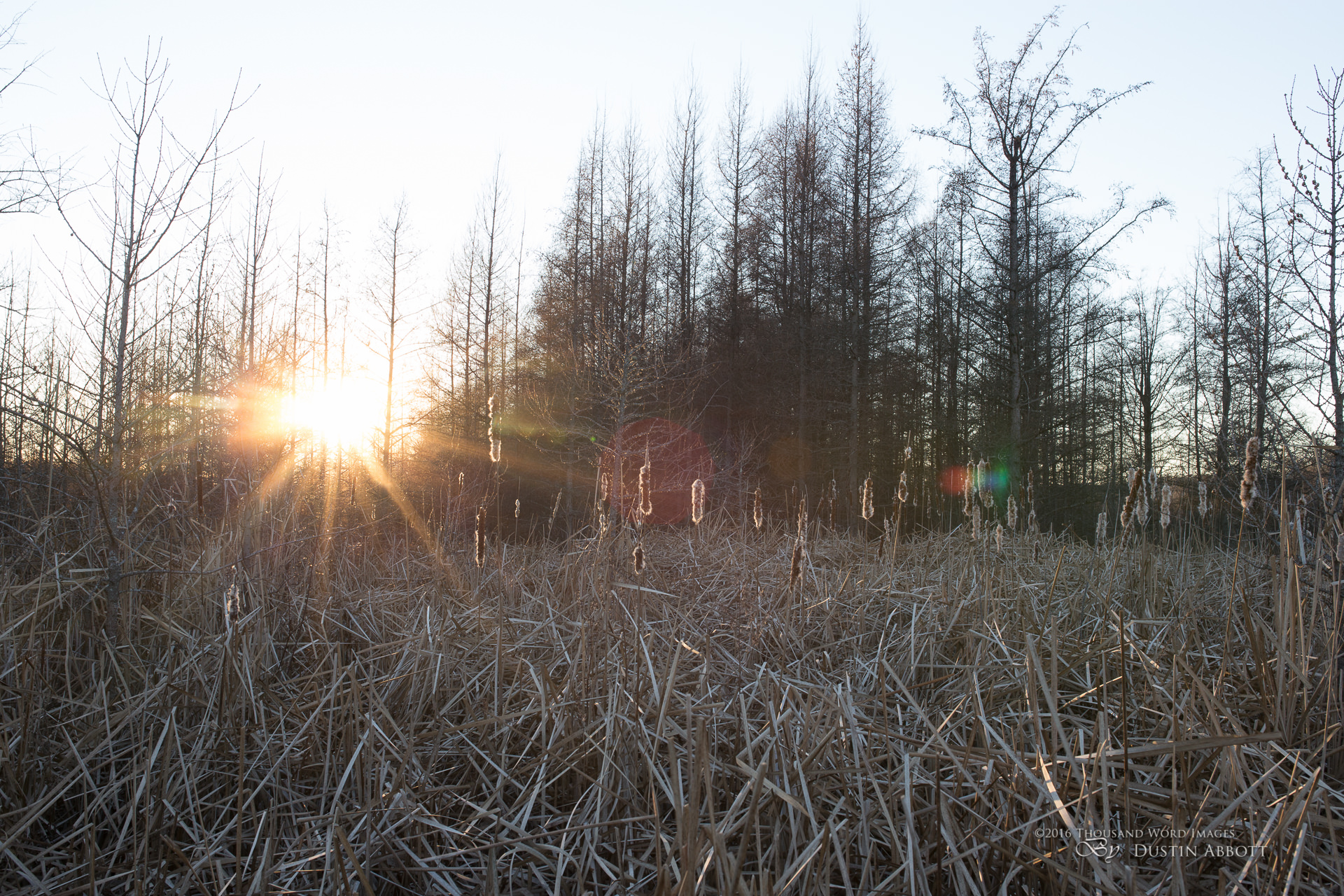

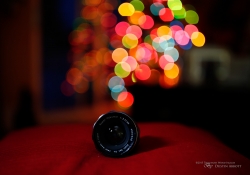
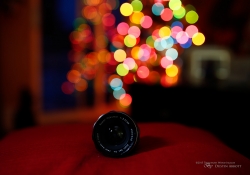
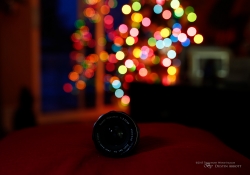
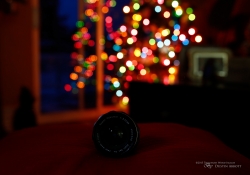

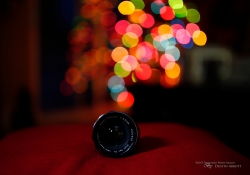
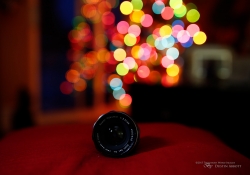
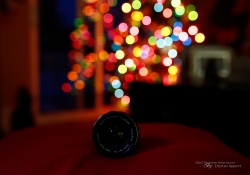

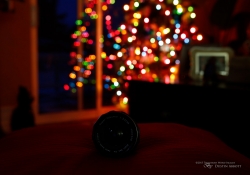
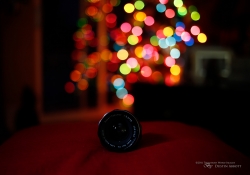

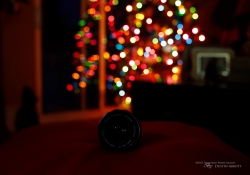

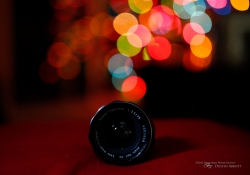
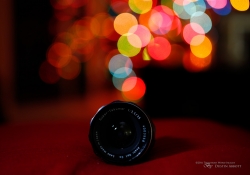
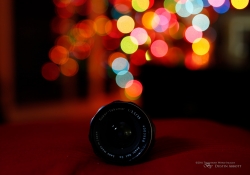
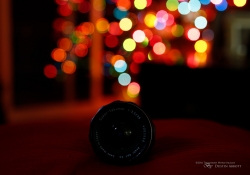
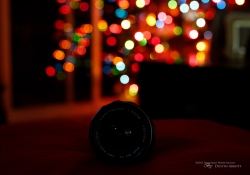










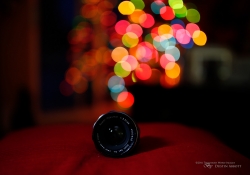



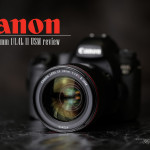







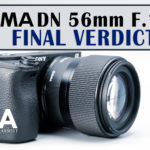
SIGMA USA has had my 35 and 50mm lenses twice trying to calibrate to infinity. I’m confident the focus problems are not QA related but a design flaw.Realistically the 3-5ft distance is the most reliable focus range and makes the most sense for these fixed focal lengths. My 85 f/1.2 gives me the distance I can’t get with the 50mm or else my 70-200 f/2.8 extends my distance. I’m very let down by all reviews except yours which is blunt and honest. It’ll be live view for infinity with these lenses wide open.
Gustave, ironically I take a lot of heat from Sigma fans for pointing out the AF deficiencies, but I try to as candid as possible about the strengths and weaknesses of all the gear I review.